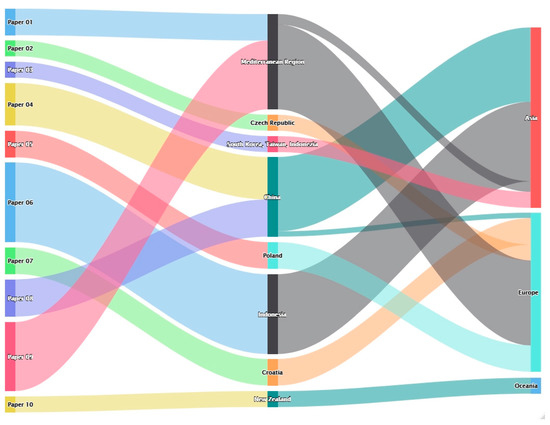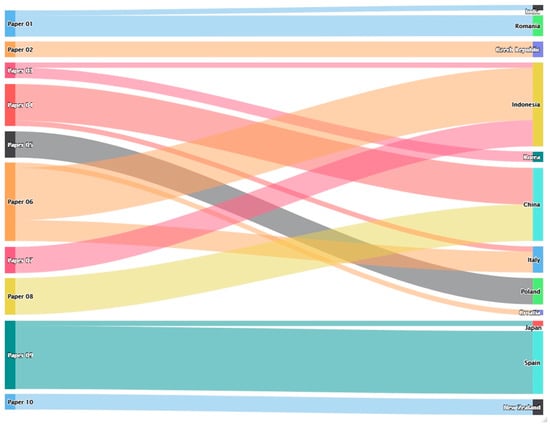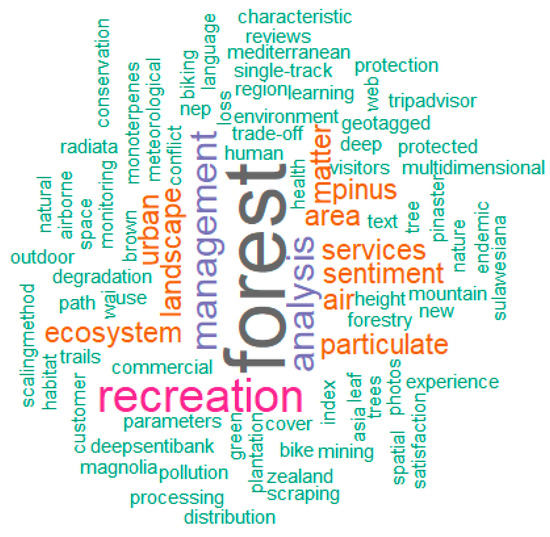1. Introduction
Forests, which are viewed as an important natural resource for humanity, have been constantly threatened with degradation or even extinction since the dawn of the modern period. Landscape protection, especially forest conservation, represents an important research topic of the last century. While forest recreation focuses on forests as the main destinations for public recreational activities, landscape protection refers to the conservation, development, and restoration of natural beauties. Urban and peri-urban forests have become places for recreational activities of populations living in big cities all over the world. The lack of green spaces is always felt by modern society within its current built environments. In recent years, demands for forest recreation activities have been increasing both in volume and in diversity. In some areas, predominantly rural ones, the forest acts as a site for the seasonal collection of berries and mushrooms (non-timber forest products, NTFPs), which are integrated into rural life as key social activities. Additionally, landscape protection measures have been imposed during the last two or three decades due to the immense, adverse human effects on all the landscape components. Landscape protection is imperatively required due to the development of human settlements over the last few decades, which may be viewed as a forceful and constant expansion. It is imposed not only for scientific and ecologic reasons but also for social and cultural ones, and this is why the driving mechanisms for managing forests in the future should be better understood.
2. The Methodology Used in the Papers of the Special Issue
2.1. Study Areas
The origins of the studies presented the papers of this Special Issue cover a large selection of countries (Figure 1), which encompass the three continents (Asia, Europe, and Oceania) and have different natural and socio-economic conditions, as reflected in their climates and microclimates, vegetation (a repartition of plant species), air quality (pollution), and different profiles of economic activities (agricultural, industrial, or services, including tourism and recreational activities). There are two papers that focus on large areas, encompassing the countries around the Mediterranean Sea [1,2]. The other papers cover smaller areas, such as islands (Sulawesi in Indonesia [3], New Zealand in Oceania [4]), countries (China, South Korea, and Taiwan [5,6]), or even smaller areas, such as mountains (Moravian Karst Plateau in the Czech Republic and Plitvice Lakes National Park in Croatia) [7,8], or cities (Warsaw in Poland and Xi’an in China) [9,10].

Figure 1.
Study areas of the papers in this Special Issue (left: paper number, according to the references; middle: study area; and right: continents). Data source: [1,2,3,4,5,6,7,8,9,10].
2.2. Data Acquisition and Processing
Authors used data obtained from diverse sources, with the data providers including official authorities [3,9,10], satellite images or GIS [3], other platforms [1,6,8], and questionnaires [4,5]. The methodologies applied are diverse and complex, from simple monitoring and descriptive statistics [1,2,7] to advanced models (Shapiro–Wilk and Kappa tests [1,3], social media content, cluster analysis, natural language processing [8], and sentiment analysis [6,8]). The processing of the data was performed using specialized software, including R Software [1,10], SPSS [4,5,9], KH Coder Software [8], and GIS [1,2,3,4,5,6,7,8,9,10].
3. Summary of the Papers in This Special Issue (Forest Recreation and Landscape Protection)
The papers published in this Special Issue, “Forest Recreation and Landscape Protection”, cover a wide range of topics that can be divided into two main categories: studies focusing on forest recreation and those focusing on landscape protection. The papers investigating forest recreation refer to the tourism activities in forests, which are regarded as leisure activities (e.g., mountain biking). The others, focusing on landscape protection, concentrate on the impact of forest (in)stability on human health (air quality) and, especially, the lack of forests and forest degradation as direct consequences of human economic activity.
In the first paper, Ciobotaru et al. [1] present the environmental issues related to forest loss in one of the important areas of the Earth, the Mediterranean region. The paper analyzes the tree cover loss and cumulative tree cover loss in each country, acting as an important index of the tendency towards tree cover loss in each country, over a total area of 581 Mha. The forest loss is determined by certain natural and anthropogenic activities, such as intense forest fires, overgrazing, agricultural expansion, and illegal logging.
In the second paper, Hrůza et al. [7] underline the important role of “controlled recreation” by building and tracing certain bike routes in the mountainous area of the Moravian Karst in Poland. While cycling has become one of the popular recreational activities of today’s world, it is also important for the distribution of groups of visitors in the area, especially the bikers, who use only the designed routes.
Kim et al. [5] offer an international comparative analysis of the perception of the natural environment in South Korea, Taiwan, and Indonesia. Using a specific methodology, the perceptions regarding environmental conservation and the use of urban forests were analyzed, and some significant differences between the three countries, which have different histories, cultures, and economic developmental levels, were identified. Among all the countries, Taiwan showed the highest positive results, while concerns regarding the “limits of growth” were significant in South Korea and those regarding the “ecological crisis” more pressing in Taiwan and Indonesia.
Jiang et al. [9] show that, as the urbanization and industrialization processes in China have accelerated, pollution has become one of the most dangerous issues in the cities. The urban green spaces, as “green infrastructure”, are an important part of the urban ecosystems, with the purposes of air purification and refreshing. By considering the meteorological factors over time, the effects of green spaces with different vegetation structures and effects on air purification were determined. The results underline the positive effect of urban green spaces on air quality, and this could be used as an important theoretical basis for optimizing the structure of urban green spaces.
Another paper focusing on air quality, Hoppa et al. [10], studies the impact of air pollution on people’s health, which presents as one of the world’s leading environmental health threats. The authors identify children as the most vulnerable social group, who are most exposed to the harmful effects of air pollution. With greater exposure time, more negative effects are observed. The study investigates the role of trees in air purification during winter, as a leafless period, on children’s school routes. The study was conducted in Warsaw, and the results obtained demonstrate the weak impact of the tree canopy in the winter season.
Based on habitat preferences, Kinho et al. [3] investigate the spatial distribution of the Magnolia genus in the northern part of Sulawesi using 786 waypoints. They confirmed that the Magnolia spp. distribution is influenced by factors such as the annual temperature range, precipitation seasonality, and elevation. Endemic and endangered species, such as Magnolia sulawesiana Brambach, Noot., and Culmsee, were identified in the central part of Sulawesi. This study could provide a scientific basis for efficient forest management and the development of conservation strategies and landscape protection measures.
Sergiacomi et al. [8] conducted a survey, using the social media TripAdvisor platform, of 15,673 visitor reviews of the Plitvice Lakes National Park in Croatia. Their aim was to detect the strengths and weaknesses of the National Park. The methods of analyses that the authors used could be applied in different countries with similar natural contexts and protected areas. The results obtained show that visitors were both interested in naturalistic and landscape aspects and the accessibility and management of routes and visits to the park.
Zeng et al. [6] used deep learning technology to select six case studies in China and to analyze geotagged photos of forest landscapes posted by forest recreationists in a specific application. The paper also used Deepsentibank to perform a sentiment analysis of forest landscape photos. This facilitates a better understanding of Chinese forest recreationists’ forest landscape preferences. The authors concluded that people preferred flat views and had a strong preference for forest trail landscapes, which plays an important role in forest landscape recreation, and that the photos evoked both positive and negative emotions.
Sancho-Knapic et al. [2] also underline the impact of air quality on human health. The study was conducted in Mediterranean forests, examining the variations in air quality under the influence of different factors (temperature and leaf development). The six most abundant monoterpenes were detected, and it was found that their abundance in the air increased after the drought period. The study results show that people who enjoy forest-based activities in Mediterranean conifer areas are more exposed to air monoterpenes when the temperature increases. This happens when the leafy canopy is well developed and after a drought period.
Bayne et al. [4] refer to recreational activities in the production forests of New Zealand. These kinds of forests offer many opportunities for mountain biking, particularly in smaller commercial peri-urban plantations and forest parks maintained as dedicated mountain bike parks. The paper explains the impacts of, and the responses of forest owners and managers to, increased mountain biking activities in commercial forest estates. This paper is useful for urban and peri-urban forest planners (managers) who accommodate recreational activities such as mountain biking in production forests. It suggests policies and best practices that can help to protect commercial interests and forest ecology.
4. Conclusions
This Special Issue, entitled “Forest Recreation and Landscape Protection”, comprises 10 papers by 59 authors from 12 countries on three continents: Asia (Indonesia, China, South Korea, India, Japan), Europe (Spain, Italy, Poland, Czech Republic, Croatia, Romania), and Oceania (New Zealand). Their multiple affiliations permitted the authors to study and research a great expanse of topics and areas related to forests, as an important natural resource and forest ecosystem service provider, as well as other elements with direct or indirect impacts on the forests (Figure 2).

Figure 2.
Authors’ affiliation(s) and country (or countries) (right) by paper, with references (left). Data source: [1,2,3,4,5,6,7,8,9,10].
Another riveting aspect is the diversity of the keywords used in the papers (Figure 3). All the papers are centered around the forest as the main keyword, appearing in diverse combinations: forest management [4,7], forest recreation [7,8], forest landscape [6], and forest air [2], plantation forest [4]. Others relate to the tree species (Magnolia sulawesiana [3], Pinus pinaster [2], Pinus radiata [4]). Other keywords relate to the activities linked to forests, such as recreational activities (visitor monitoring [7], nature experience [5], single-track bike trails [7], TripAdvisor reviews [8], geotagged photos [6], path analysis [2]) and economic activities (commercial forestry, trade-off [4]). Other keywords center on the landscape, the other key focus of this Special Issue, and associated terms such as environment [1], landscape protection, and conservation [3].

Figure 3.
Keywords of the papers in this Special Issue. Data source: [1,2,3,4,5,6,7,8,9,10].
Figure 4 offers an illustration of this multitude of 58 keywords grouped into 11 families, from all 10 papers (economic activity, environment, impact, index, landscape, management, methodology, pollution, region, resources, and tourism). The family of the key words is placed in the middle of the Figure, the paper numbers are on the left side, and the keywords are on the right side of Figure 4.

Figure 4.
Papers in the Special Issue/family of keywords/keywords. Data source: [1,2,3,4,5,6,7,8,9,10].
The papers from this Special Issue adopt an interdisciplinary approach that considers the aspects affecting forest degradation, including tree cover loss and deforestation, on the one hand, and those that lead to landscape conservation and protection, on the other. All the papers use an adequate and modern variety of methodologies, providing a real source of inspiration for further research papers and Ph.D. theses.
Funding
This research received no external funding.
Conflicts of Interest
The author declares no conflict of interest.
References
- Ciobotaru, A.-M.; Patel, N.; Pintilii, R.-D. Tree Cover Loss in the Mediterranean Region—An Increasingly Serious Environmental Issue. Forests 2021, 12, 1341. [Google Scholar] [CrossRef]
- Sancho-Knapik, D.; Gil-Pelegrín, E.; Ferrio, J.P.; Alonso-Forn, D.; Martín-Sánchez, R.; dos Santos Silva, J.V.; Imanishi, J.; Peguero-Pina, J.J.; Sanz, M.Á. Changes in the Abundance of Monoterpenes from Breathable Air of a Mediterranean Conifer Forest: When Is the Best Time for a Human Healthy Leisure Activity? Forests 2022, 13, 965. [Google Scholar] [CrossRef]
- Kinho, J.; Arini, D.I.D.; Abdulah, L.; Susanti, R.; Irawan, A.; Yulianti, M.; Subarudi, S.; Imanuddin, R.; Wardani, M.; Denny, D.; et al. Habitat Characteristics of Magnolia Based on Spatial Analysis: Landscape Protection to Conserve Endemic and Endangered Magnolia sulawesiana Brambach, Noot., and Culmsee. Forests 2022, 13, 802. [Google Scholar] [CrossRef]
- Bayne, K.M.; Scott, M.B.; Yao, R.T. Getting Flow: The Place of Production Forests in the Rise of Mountain Biking. Forests 2022, 13, 1326. [Google Scholar] [CrossRef]
- Kim, D.; Avenzora, R.; Lee, J.-h. Exploring the Outdoor Recreational Behavior and New Environmental Paradigm among Urban Forest Visitors in Korea, Taiwan and Indonesia. Forests 2021, 12, 1651. [Google Scholar] [CrossRef]
- Zeng, X.; Zhong, Y.; Yang, L.; Wei, J.; Tang, X. Analysis of Forest Landscape Preferences and Emotional Features of Chinese Forest Recreationists Based on Deep Learning of Geotagged Photos. Forests 2022, 13, 892. [Google Scholar] [CrossRef]
- Hrůza, P.; Pelikaán, P.; Olišarová, L. Single-Track Bike Trails in the Moravian Karst as Part of Forest Recreation. Forests 2021, 12, 1601. [Google Scholar] [CrossRef]
- Sergiacomi, C.; Vuletić, D.; Paletto, A.; Barbierato, E.; Fagarazzi, C. Exploring National Park Visitors’ Judgements from Social Media: The Case Study of Plitvice Lakes National Park. Forests 2022, 13, 717. [Google Scholar] [CrossRef]
- Jiang, B.; Sun, C.; Mu, S.; Zhao, Z.; Chen, Y.; Lin, Y.; Qiu, L.; Gao, T. Differences in Airborne Particulate Matter Concentration in Urban Green Spaces with Different Spatial Structures in Xi’an, China. Forests 2022, 13, 14. [Google Scholar] [CrossRef]
- Hoppa, A.; Sikorska, D.; Przybysz, A.; Melon, M.; Sikorski, P. The Role of Trees in Winter Air Purification on Children’s Routes to School. Forests 2022, 13, 40. [Google Scholar] [CrossRef]
Publisher’s Note: MDPI stays neutral with regard to jurisdictional claims in published maps and institutional affiliations. |
© 2022 by the author. Licensee MDPI, Basel, Switzerland. This article is an open access article distributed under the terms and conditions of the Creative Commons Attribution (CC BY) license (https://creativecommons.org/licenses/by/4.0/).